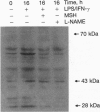Abstract
alpha-Melanocyte-stimulating hormone (alpha-MSH) is a potent inhibitory agent in all major forms of inflammation. To identify a potential mechanism of antiinflammatory action of alpha-MSH, we tested its effects on production of nitric oxide (NO), believed to be a mediator common to all forms of inflammation. We measured NO and alpha-MSH production in RAW 264.7 cultured murine macrophages stimulated with bacterial lipopolysaccharide and interferon gamma. alpha-MSH inhibited production of NO, as estimated from nitrite production and nitration of endogenous macrophage proteins. This occurred through inhibition of production of NO synthase II protein; steady-state NO synthase II mRNA abundance was also reduced. alpha-MSH increased cAMP accumulation in RAW cells, characteristic of alpha-MSH receptors in other cell types. RAW cells also expressed mRNA for the primary alpha-MSH receptor (melanocortin 1). mRNA for proopiomelanocortin, the precursor molecular of alpha-MSH, was expressed in RAW cells, and tumor necrosis factor alpha increased production and release of alpha-MSH. These results suggest that the proinflammatory cytokine tumor necrosis factor alpha can induce macrophages to increase production of alpha-MSH, which then becomes available to act upon melanocortin receptors on the same cells. Such stimulation of melanocortin receptors could modulate inflammation by inhibiting the production of NO. The results suggest that alpha-MSH is an autocrine factor in macrophages which modulates inflammation by counteracting the effects of proinflammatory cytokines.
Full text
PDF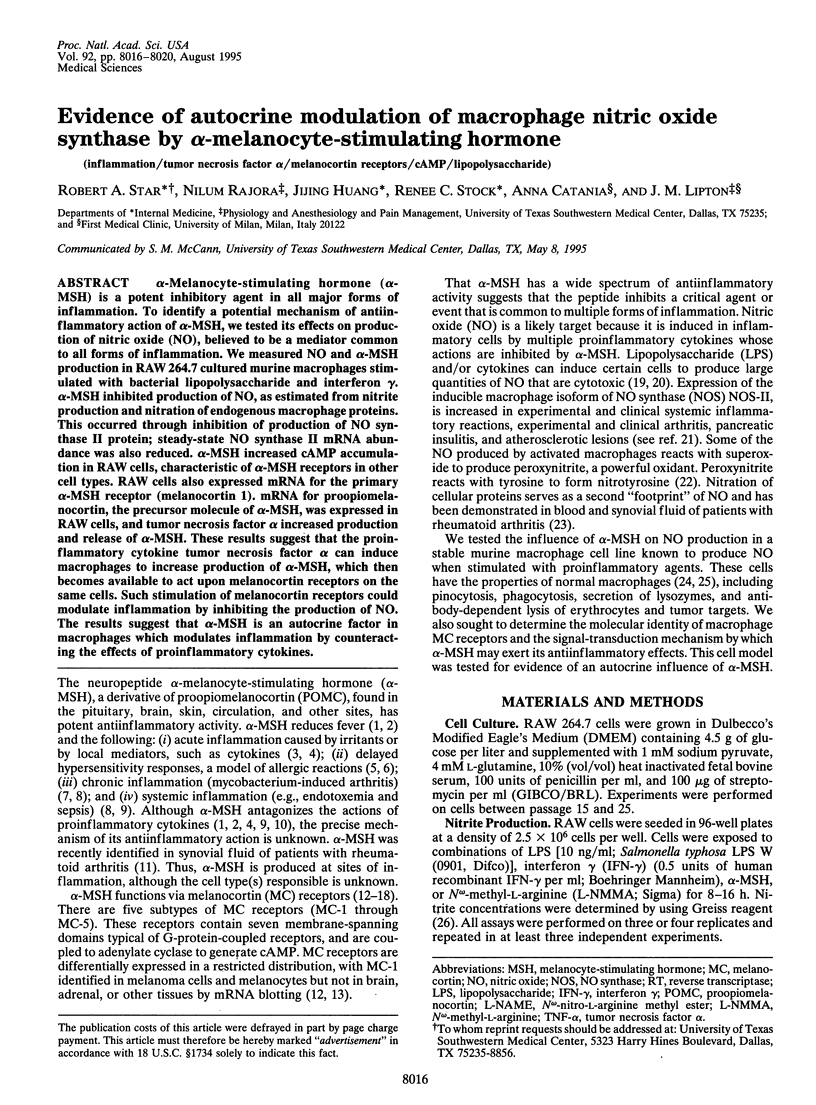
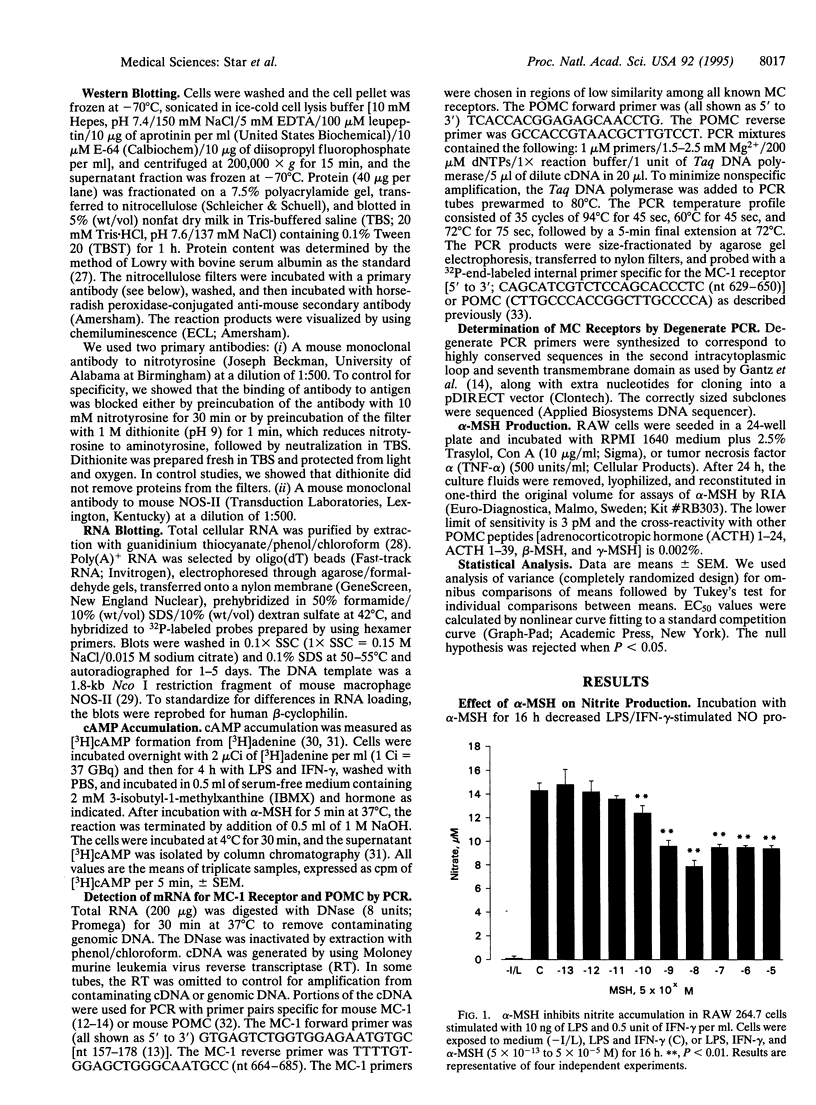
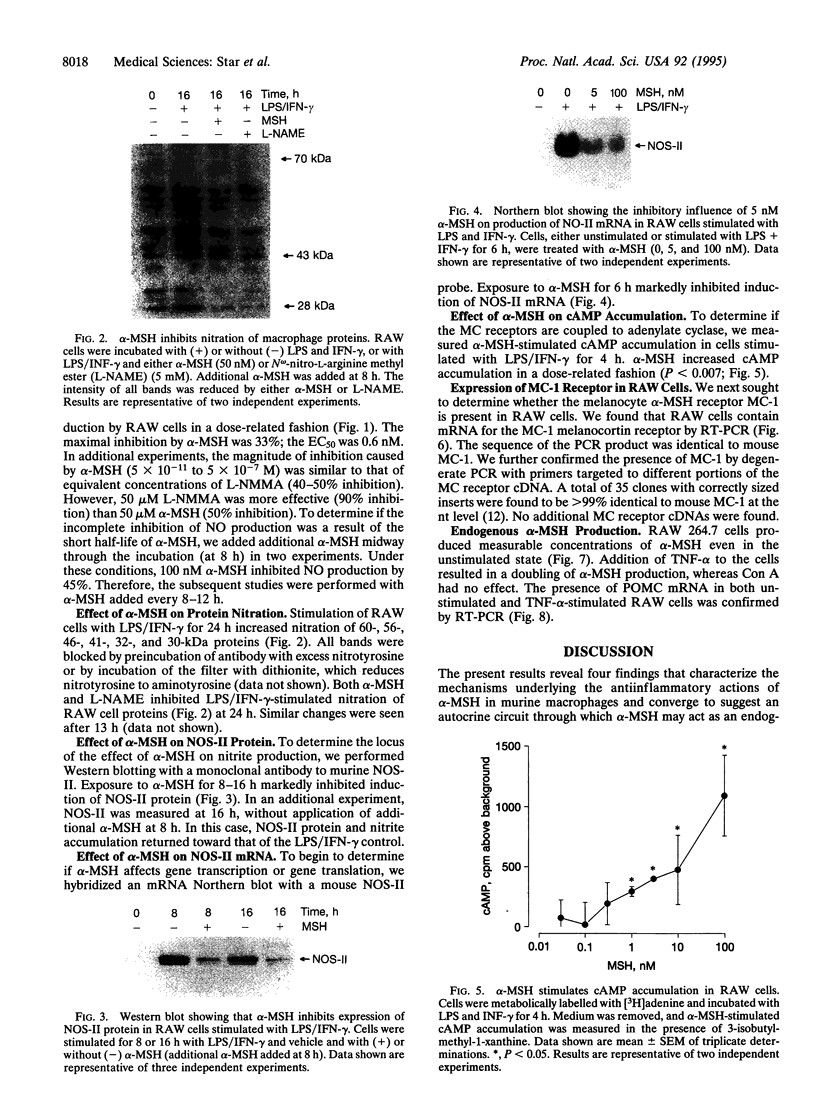
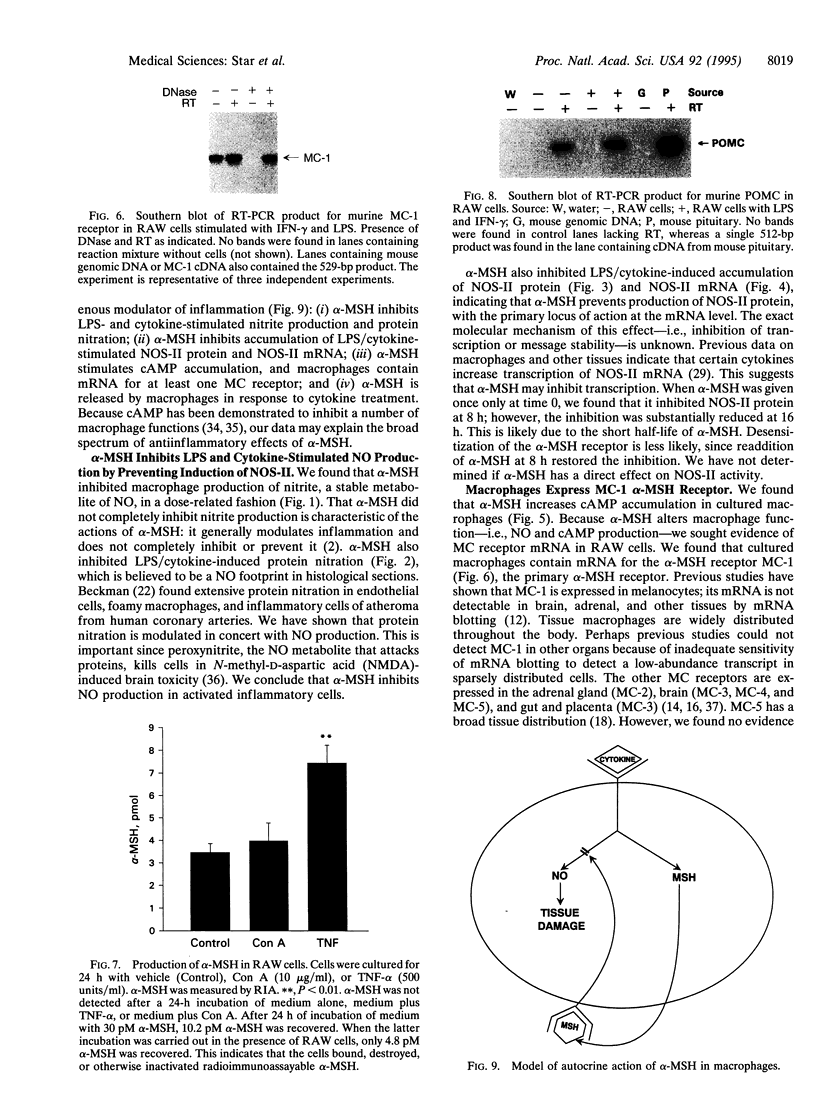
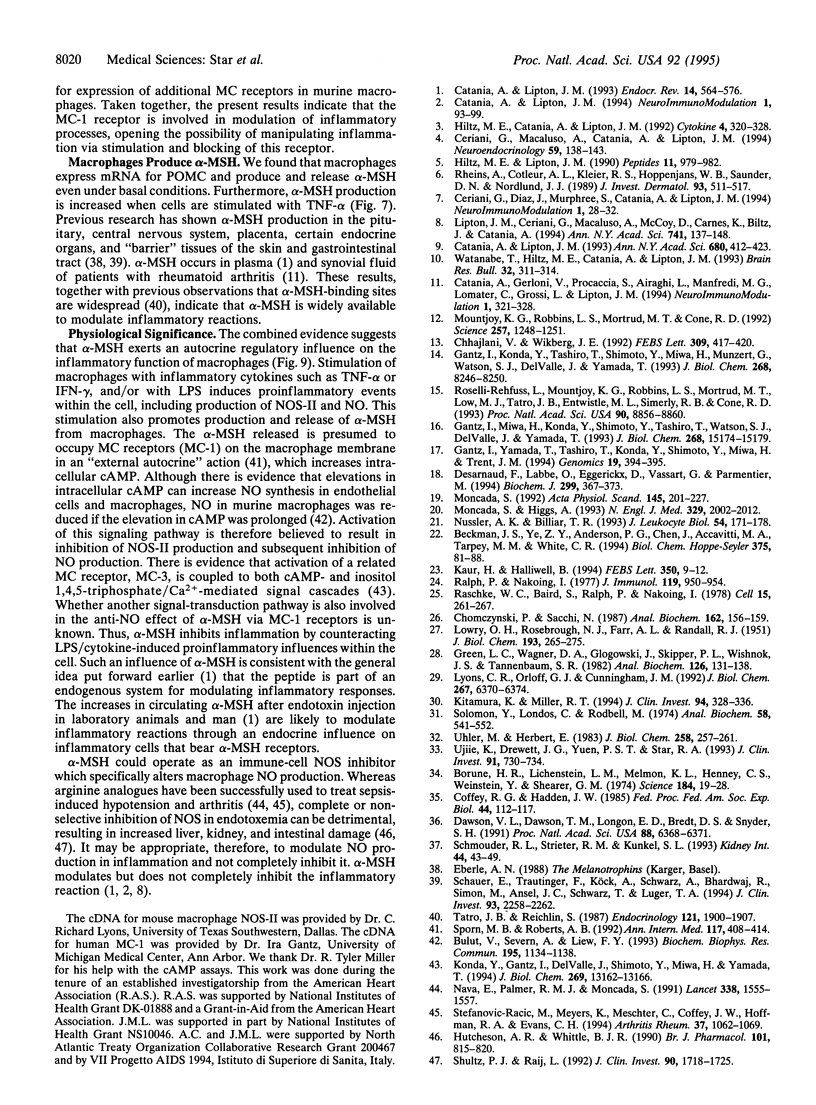
Images in this article
Selected References
These references are in PubMed. This may not be the complete list of references from this article.
- Beckmann J. S., Ye Y. Z., Anderson P. G., Chen J., Accavitti M. A., Tarpey M. M., White C. R. Extensive nitration of protein tyrosines in human atherosclerosis detected by immunohistochemistry. Biol Chem Hoppe Seyler. 1994 Feb;375(2):81–88. doi: 10.1515/bchm3.1994.375.2.81. [DOI] [PubMed] [Google Scholar]
- Bourne H. R., Lichtenstein L. M., Melmon K. L., Henney C. S., Weinstein Y., Shearer G. M. Modulation of inflammation and immunity by cyclic AMP. Science. 1974 Apr 5;184(4132):19–28. doi: 10.1126/science.184.4132.19. [DOI] [PubMed] [Google Scholar]
- Bulut V., Severn A., Liew F. Y. Nitric oxide production by murine macrophages is inhibited by prolonged elevation of cyclic AMP. Biochem Biophys Res Commun. 1993 Sep 15;195(2):1134–1138. doi: 10.1006/bbrc.1993.2162. [DOI] [PubMed] [Google Scholar]
- Catania A., Gerloni V., Procaccia S., Airaghi L., Manfredi M. G., Lomater C., Grossi L., Lipton J. M. The anticytokine neuropeptide alpha-melanocyte-stimulating hormone in synovial fluid of patients with rheumatic diseases: comparisons with other anticytokine molecules. Neuroimmunomodulation. 1994 Sep-Oct;1(5):321–328. doi: 10.1159/000097183. [DOI] [PubMed] [Google Scholar]
- Catania A., Lipton J. M. Alpha-melanocyte-stimulating hormone peptides in host responses. From basic evidence to human research. Ann N Y Acad Sci. 1993 May 31;680:412–423. doi: 10.1111/j.1749-6632.1993.tb19699.x. [DOI] [PubMed] [Google Scholar]
- Catania A., Lipton J. M. The neuropeptide alpha-melanocyte-stimulating hormone: a key component of neuroimmunomodulation. Neuroimmunomodulation. 1994 Mar-Apr;1(2):93–99. doi: 10.1159/000097096. [DOI] [PubMed] [Google Scholar]
- Catania A., Lipton J. M. alpha-Melanocyte stimulating hormone in the modulation of host reactions. Endocr Rev. 1993 Oct;14(5):564–576. doi: 10.1210/edrv-14-5-564. [DOI] [PubMed] [Google Scholar]
- Ceriani G., Diaz J., Murphree S., Catania A., Lipton J. M. The neuropeptide alpha-melanocyte-stimulating hormone inhibits experimental arthritis in rats. Neuroimmunomodulation. 1994 Jan;1(1):28–32. doi: 10.1159/000097087. [DOI] [PubMed] [Google Scholar]
- Ceriani G., Macaluso A., Catania A., Lipton J. M. Central neurogenic antiinflammatory action of alpha-MSH: modulation of peripheral inflammation induced by cytokines and other mediators of inflammation. Neuroendocrinology. 1994 Feb;59(2):138–143. doi: 10.1159/000126650. [DOI] [PubMed] [Google Scholar]
- Chhajlani V., Wikberg J. E. Molecular cloning and expression of the human melanocyte stimulating hormone receptor cDNA. FEBS Lett. 1992 Sep 14;309(3):417–420. doi: 10.1016/0014-5793(92)80820-7. [DOI] [PubMed] [Google Scholar]
- Chomczynski P., Sacchi N. Single-step method of RNA isolation by acid guanidinium thiocyanate-phenol-chloroform extraction. Anal Biochem. 1987 Apr;162(1):156–159. doi: 10.1006/abio.1987.9999. [DOI] [PubMed] [Google Scholar]
- Coffey R. G., Hadden J. W. Neurotransmitters, hormones, and cyclic nucleotides in lymphocyte regulation. Fed Proc. 1985 Jan;44(1 Pt 1):112–117. [PubMed] [Google Scholar]
- Dawson V. L., Dawson T. M., London E. D., Bredt D. S., Snyder S. H. Nitric oxide mediates glutamate neurotoxicity in primary cortical cultures. Proc Natl Acad Sci U S A. 1991 Jul 15;88(14):6368–6371. doi: 10.1073/pnas.88.14.6368. [DOI] [PMC free article] [PubMed] [Google Scholar]
- Desarnaud F., Labbe O., Eggerickx D., Vassart G., Parmentier M. Molecular cloning, functional expression and pharmacological characterization of a mouse melanocortin receptor gene. Biochem J. 1994 Apr 15;299(Pt 2):367–373. doi: 10.1042/bj2990367. [DOI] [PMC free article] [PubMed] [Google Scholar]
- Gantz I., Konda Y., Tashiro T., Shimoto Y., Miwa H., Munzert G., Watson S. J., DelValle J., Yamada T. Molecular cloning of a novel melanocortin receptor. J Biol Chem. 1993 Apr 15;268(11):8246–8250. [PubMed] [Google Scholar]
- Gantz I., Miwa H., Konda Y., Shimoto Y., Tashiro T., Watson S. J., DelValle J., Yamada T. Molecular cloning, expression, and gene localization of a fourth melanocortin receptor. J Biol Chem. 1993 Jul 15;268(20):15174–15179. [PubMed] [Google Scholar]
- Gantz I., Yamada T., Tashiro T., Konda Y., Shimoto Y., Miwa H., Trent J. M. Mapping of the gene encoding the melanocortin-1 (alpha-melanocyte stimulating hormone) receptor (MC1R) to human chromosome 16q24.3 by Fluorescence in situ hybridization. Genomics. 1994 Jan 15;19(2):394–395. doi: 10.1006/geno.1994.1080. [DOI] [PubMed] [Google Scholar]
- Green L. C., Wagner D. A., Glogowski J., Skipper P. L., Wishnok J. S., Tannenbaum S. R. Analysis of nitrate, nitrite, and [15N]nitrate in biological fluids. Anal Biochem. 1982 Oct;126(1):131–138. doi: 10.1016/0003-2697(82)90118-x. [DOI] [PubMed] [Google Scholar]
- Hiltz M. E., Catania A., Lipton J. M. Alpha-MSH peptides inhibit acute inflammation induced in mice by rIL-1 beta, rIL-6, rTNF-alpha and endogenous pyrogen but not that caused by LTB4, PAF and rIL-8. Cytokine. 1992 Jul;4(4):320–328. doi: 10.1016/1043-4666(92)90073-z. [DOI] [PubMed] [Google Scholar]
- Hiltz M. E., Lipton J. M. Alpha-MSH peptides inhibit acute inflammation and contact sensitivity. Peptides. 1990 Sep-Oct;11(5):979–982. doi: 10.1016/0196-9781(90)90020-6. [DOI] [PubMed] [Google Scholar]
- Hutcheson I. R., Whittle B. J., Boughton-Smith N. K. Role of nitric oxide in maintaining vascular integrity in endotoxin-induced acute intestinal damage in the rat. Br J Pharmacol. 1990 Dec;101(4):815–820. doi: 10.1111/j.1476-5381.1990.tb14163.x. [DOI] [PMC free article] [PubMed] [Google Scholar]
- Kaur H., Halliwell B. Evidence for nitric oxide-mediated oxidative damage in chronic inflammation. Nitrotyrosine in serum and synovial fluid from rheumatoid patients. FEBS Lett. 1994 Aug 15;350(1):9–12. doi: 10.1016/0014-5793(94)00722-5. [DOI] [PubMed] [Google Scholar]
- Kitamura K., Miller R. T. Regulation of hormone-sensitive calcium influx by the adenylyl cyclase system in renal epithelial cells. J Clin Invest. 1994 Jul;94(1):328–336. doi: 10.1172/JCI117325. [DOI] [PMC free article] [PubMed] [Google Scholar]
- Konda Y., Gantz I., DelValle J., Shimoto Y., Miwa H., Yamada T. Interaction of dual intracellular signaling pathways activated by the melanocortin-3 receptor. J Biol Chem. 1994 May 6;269(18):13162–13166. [PubMed] [Google Scholar]
- LOWRY O. H., ROSEBROUGH N. J., FARR A. L., RANDALL R. J. Protein measurement with the Folin phenol reagent. J Biol Chem. 1951 Nov;193(1):265–275. [PubMed] [Google Scholar]
- Lipton J. M., Ceriani G., Macaluso A., McCoy D., Carnes K., Biltz J., Catania A. Antiinflammatory effects of the neuropeptide alpha-MSH in acute, chronic, and systemic inflammation. Ann N Y Acad Sci. 1994 Nov 25;741:137–148. doi: 10.1111/j.1749-6632.1994.tb39654.x. [DOI] [PubMed] [Google Scholar]
- Lyons C. R., Orloff G. J., Cunningham J. M. Molecular cloning and functional expression of an inducible nitric oxide synthase from a murine macrophage cell line. J Biol Chem. 1992 Mar 25;267(9):6370–6374. [PubMed] [Google Scholar]
- Moncada S., Higgs A. The L-arginine-nitric oxide pathway. N Engl J Med. 1993 Dec 30;329(27):2002–2012. doi: 10.1056/NEJM199312303292706. [DOI] [PubMed] [Google Scholar]
- Moncada S. The 1991 Ulf von Euler Lecture. The L-arginine: nitric oxide pathway. Acta Physiol Scand. 1992 Jul;145(3):201–227. doi: 10.1111/j.1748-1716.1992.tb09359.x. [DOI] [PubMed] [Google Scholar]
- Mountjoy K. G., Robbins L. S., Mortrud M. T., Cone R. D. The cloning of a family of genes that encode the melanocortin receptors. Science. 1992 Aug 28;257(5074):1248–1251. doi: 10.1126/science.1325670. [DOI] [PubMed] [Google Scholar]
- Nava E., Palmer R. M., Moncada S. Inhibition of nitric oxide synthesis in septic shock: how much is beneficial? Lancet. 1991 Dec 21;338(8782-8783):1555–1557. doi: 10.1016/0140-6736(91)92375-c. [DOI] [PubMed] [Google Scholar]
- Nussler A. K., Billiar T. R. Inflammation, immunoregulation, and inducible nitric oxide synthase. J Leukoc Biol. 1993 Aug;54(2):171–178. [PubMed] [Google Scholar]
- Ralph P., Nakoinz I. Antibody-dependent killing of erythrocyte and tumor targets by macrophage-related cell lines: enhancement by PPD and LPS. J Immunol. 1977 Sep;119(3):950–954. [PubMed] [Google Scholar]
- Raschke W. C., Baird S., Ralph P., Nakoinz I. Functional macrophage cell lines transformed by Abelson leukemia virus. Cell. 1978 Sep;15(1):261–267. doi: 10.1016/0092-8674(78)90101-0. [DOI] [PubMed] [Google Scholar]
- Rheins L. A., Cotleur A. L., Kleier R. S., Hoppenjans W. B., Saunder D. N., Nordlund J. J. Alpha-melanocyte stimulating hormone modulates contact hypersensitivity responsiveness in C57/BL6 mice. J Invest Dermatol. 1989 Oct;93(4):511–517. doi: 10.1111/1523-1747.ep12284064. [DOI] [PubMed] [Google Scholar]
- Roselli-Rehfuss L., Mountjoy K. G., Robbins L. S., Mortrud M. T., Low M. J., Tatro J. B., Entwistle M. L., Simerly R. B., Cone R. D. Identification of a receptor for gamma melanotropin and other proopiomelanocortin peptides in the hypothalamus and limbic system. Proc Natl Acad Sci U S A. 1993 Oct 1;90(19):8856–8860. doi: 10.1073/pnas.90.19.8856. [DOI] [PMC free article] [PubMed] [Google Scholar]
- Salomon Y., Londos C., Rodbell M. A highly sensitive adenylate cyclase assay. Anal Biochem. 1974 Apr;58(2):541–548. doi: 10.1016/0003-2697(74)90222-x. [DOI] [PubMed] [Google Scholar]
- Schauer E., Trautinger F., Köck A., Schwarz A., Bhardwaj R., Simon M., Ansel J. C., Schwarz T., Luger T. A. Proopiomelanocortin-derived peptides are synthesized and released by human keratinocytes. J Clin Invest. 1994 May;93(5):2258–2262. doi: 10.1172/JCI117224. [DOI] [PMC free article] [PubMed] [Google Scholar]
- Schmouder R. L., Strieter R. M., Kunkel S. L. Interferon-gamma regulation of human renal cortical epithelial cell-derived monocyte chemotactic peptide-1. Kidney Int. 1993 Jul;44(1):43–49. doi: 10.1038/ki.1993.211. [DOI] [PubMed] [Google Scholar]
- Shultz P. J., Raij L. Endogenously synthesized nitric oxide prevents endotoxin-induced glomerular thrombosis. J Clin Invest. 1992 Nov;90(5):1718–1725. doi: 10.1172/JCI116045. [DOI] [PMC free article] [PubMed] [Google Scholar]
- Sporn M. B., Roberts A. B. Autocrine secretion--10 years later. Ann Intern Med. 1992 Sep 1;117(5):408–414. doi: 10.7326/0003-4819-117-5-408. [DOI] [PubMed] [Google Scholar]
- Stefanovic-Racic M., Meyers K., Meschter C., Coffey J. W., Hoffman R. A., Evans C. H. N-monomethyl arginine, an inhibitor of nitric oxide synthase, suppresses the development of adjuvant arthritis in rats. Arthritis Rheum. 1994 Jul;37(7):1062–1069. doi: 10.1002/art.1780370712. [DOI] [PubMed] [Google Scholar]
- Tatro J. B., Reichlin S. Specific receptors for alpha-melanocyte-stimulating hormone are widely distributed in tissues of rodents. Endocrinology. 1987 Nov;121(5):1900–1907. doi: 10.1210/endo-121-5-1900. [DOI] [PubMed] [Google Scholar]
- Uhler M., Herbert E. Complete amino acid sequence of mouse pro-opiomelanocortin derived from the nucleotide sequence of pro-opiomelanocortin cDNA. J Biol Chem. 1983 Jan 10;258(1):257–261. [PubMed] [Google Scholar]
- Ujiie K., Drewett J. G., Yuen P. S., Star R. A. Differential expression of mRNA for guanylyl cyclase-linked endothelium-derived relaxing factor receptor subunits in rat kidney. J Clin Invest. 1993 Feb;91(2):730–734. doi: 10.1172/JCI116255. [DOI] [PMC free article] [PubMed] [Google Scholar]
- Watanabe T., Hiltz M. E., Catania A., Lipton J. M. Inhibition of IL-1 beta-induced peripheral inflammation by peripheral and central administration of analogs of the neuropeptide alpha-MSH. Brain Res Bull. 1993;32(3):311–314. doi: 10.1016/0361-9230(93)90192-e. [DOI] [PubMed] [Google Scholar]



